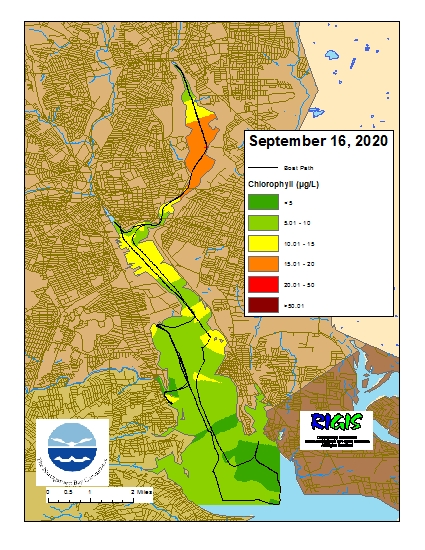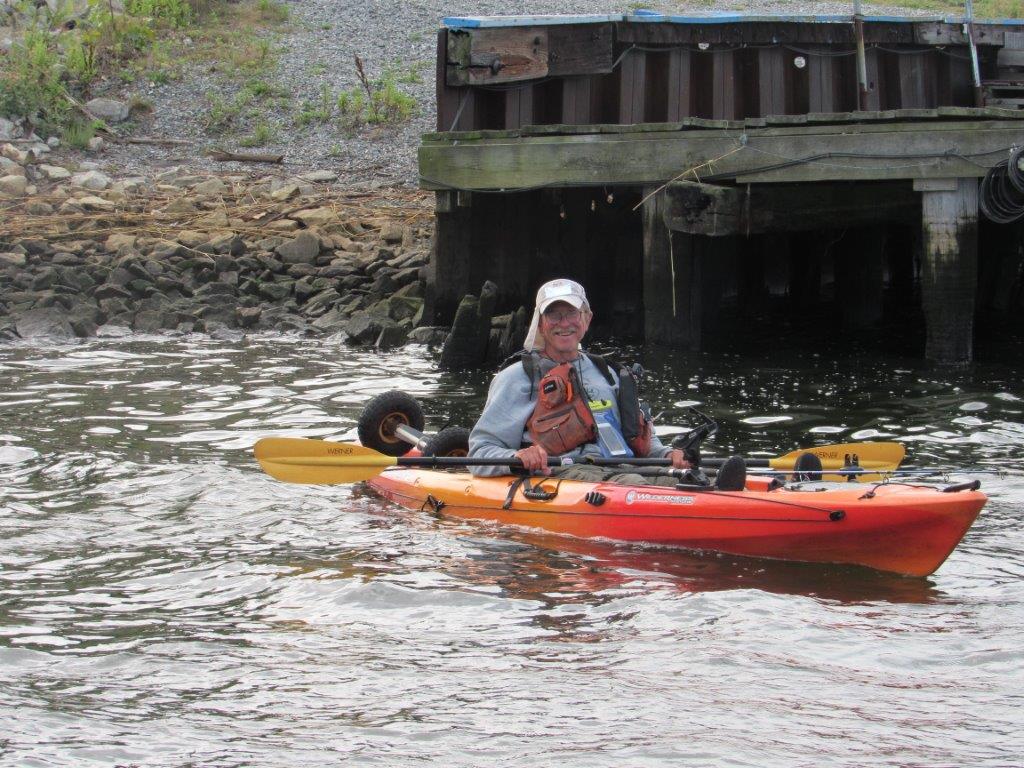Historical News
Bacteria Sampling
Twenty stations were sampled for fecal coliform in the Providence and Seekonk Rivers on September 16, 2020. Five of these stations were also sampled for enterococci bacteria. Conditions leading up to the September 16 sampling day were dry with no recorded rainfall over the five days prior.
The geometric mean of fecal coliform results for all sites was 21 MPN/100 mL, with Seekonk River sites having higher counts than Providence River sites (geometric means of 93 and 10 MPN/100 mL, respectively). The maximum count (430 MPN/100 mL) was measured at three sites; Division St. Dock and Bishop Point in the Seekonk River and Point St. Bridge in the Providence River. Fecal coliform results in the Providence River were within the state standards for primary contact and shellfishing, however, results from the Seekonk River exceeded both state standards.
The enterococci results increased from the previous sampling event, from an overall geomean of 11 MPN/100 mL to 18 MPN/100 mL. Enterococci results ranged from <10 MPN/100 mL at Gaspee Pt. to 116 MPN/100 mL at Point St. Bridge site. Enterococci results from both the Seekonk and Providence Rivers exceeded state primary contact standards.
Please note: the results of NBC's fecal coliform and enterococci monitoring are for informational/research purposes only and are not to intended to suggest official state compliance with bathing or shellfishing standards.
Surface Mapping
Data
were collected on September 16, 2020 while the R/V Monitor was underway
collecting bacteria samples and performing vertical profiles in the Providence
and Seekonk River estuaries. The chlorophyll concentrations were good to fair in
the areas surveyed. From north to south, average chlorophyll concentrations
were as follows: Seekonk River (12.55 µg/L), Upper Providence River (8.90 µg/L), Edgewood Shoals area (7.37
µg/L), Pawtuxet River area (8.37 µg/L), and Lower Providence River area (5.42
µg/L). Overall, chlorophyll ranged between 2.20 µg/L and 21.60 µg/L with an
overall average of 8.69 µg/L. The chlorophyll data from this date are
presented in the map below:

R/V Monitor's Blog
On Wednesday, September 16th, the crew of the R/V Monitor was out on the upper Bay collecting bacteria samples, taking Secchi Disk and Par sensor water clarity measurements, conducting water column profiles using the Seabird instrument, and conducting real-time surface mapping of water quality parameters including dissolved oxygen, chlorophyll, water temperature, salinity, and pH, all in an effort to document water quality improvements associated with NBC construction projects. Sara captained the boat while monitoring professionals Bekki, Gerard and Sara collected the samples and data. In the afternoon, Jeff captained the boat while the crew serviced the temporary buoy located in Pawtuxet Cove and collected a chlorophyll sample at that site. The day started brisk with little wind and a hazy sky. By afternoon, the sun broke through the haze, warming the air up nicely and a Southwest wind developed. The featured photo is of a kayaker enjoying the day by Phillipsdale landing in the Seekonk River.

R/V Monitor's Blog
On Wednesday, September 16th, the crew of the R/V Monitor was out on the upper Bay collecting bacteria samples, taking Secchi Disk and Par sensor water clarity measurements, conducting water column profiles using the Seabird instrument, and conducting real-time surface mapping of water quality parameters including dissolved oxygen, chlorophyll, water temperature, salinity, and pH, all in an effort to document water quality improvements associated with NBC construction projects. Sara captained the boat while monitoring professionals Bekki, Gerard and Sara collected the samples and data. In the afternoon, Jeff captained the boat while the crew serviced the temporary buoy located in Pawtuxet Cove and collected a chlorophyll sample at that site. The day started brisk with little wind and a hazy sky. By afternoon, the sun broke through the haze, warming the air up nicely and a Southwest wind developed. The featured photo is of a kayaker enjoying the day by Phillipsdale landing in the Seekonk River.

Fixed Site Network
Water quality was fair to poor this week at Phillipsdale Landing. Conditions have been relatively dry; precipitation totaled 0.03 inches this week.
Water column salinity increased over the course of the week. Surface salinity averaged 20.8 ppt and ranged from 15.0 ppt to 25.6 ppt. Bottom salinity averaged 26.5 ppt and ranged from 20.1 ppt to 30.3 ppt. This week, surface and bottom temperatures averaged 23.5°C and 23.3°C, respectively. Surface temperatures ranged from 20.0°C to 25.2°C, while bottom temperatures ranged from 22.2°C to 24.4°C.
Dissolved oxygen (DO) concentrations remained above the hypoxia threshold (2.9 mg/L) at the surface depth through the duration of the deployment. Surface DO averaged 7.8 mg/L, with a minimum of 4.2 mg/L. Hypoxic conditions (DO ≤ 2.9 mg/L) were observed in bottom waters, where a minimum DO concentration of 1.1 mg/L was recorded in the latter half of the week. Bottom DO averaged 3.6 mg/L for the deployment period. Surface chlorophyll averaged 45.6 ug/L, while bottom chlorophyll readings averaged 16.7 ug/L; maximum readings observed at both depths were > 45 ug/L. Please note that tidal fluctuations and Blackstone River flow greatly influence water column salinity, temperature, and DO at this location.
Bullock Reach
Water quality was good this week at Bullock Reach. Sondes were changed out for routine maintenance on the morning of September 9. Please note, a specific conductivity/temperature sensor was replaced on the mid-depth sonde on September 3rd after the sensor sustained damage in the field; impacted data are excluded from this analysis. Surface salinity averaged 29.2 ppt and ranged from 26.6 ppt to 30.4 ppt. Salinity increased with depth, averaging 30.4 ppt at the middle of the water column (range: 28.0 ppt to 32.1 ppt) and 31.2 ppt at the bottom of the water column (range: 30.3 ppt to 32.2 ppt). Temperatures averaged 23.0°C, 22.7°C, and 22.1°C at the surface, middle, and bottom of the water column, respectively. Surface temperatures ranged from 21.5°C to 24.5°C, mid temperatures ranged from 21.7°C to 23.7°C, and bottom temperatures ranged from 21.3°C to 22.7°C.
Dissolved oxygen (DO) concentrations remained above the hypoxia threshold (2.9 mg/L) at the surface depth. Surface DO averaged 7.9 mg/L, with a minimum of 5.9 mg/L. Mid DO averaged 6.2 mg/L, with a minimum of 2.6 mg/L, and bottom DO averaged 4.1 mg/L, with a minimum of 1.3 mg/L. Bottom DO generally decreased over the course of the week, as salinity stratification increased. Surface chlorophyll averaged 12.4 ug/L, mid chlorophyll averaged 7.3 ug/L, and bottom chlorophyll averaged 31.3 ug/L this week, with maximum concentrations of > 30 ug/L observed at all depths.



